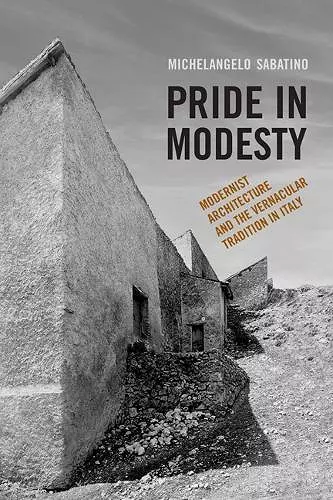Pride in Modesty
Modernist Architecture and the Vernacular Tradition in Italy
Format:Paperback
Publisher:University of Toronto Press
Published:21st May '11
Currently unavailable, and unfortunately no date known when it will be back

'Sabatino's richly detailed and contextualized history of the vernacular documents a whole other legacy of architectural practice and nationalist ideology in twentieth-century Italy. This revelatory book challenges the dominant assumptions that building under fascism was restricted to competing styles of rhetorical romanita, modernist classicism, and rationalism. It also demonstrates that the vernacular was not homogeneous, but as diverse as the regions of Italy. Through a close reading of literature, ethnography, and architecture, Sabatino shows that these varying interpretations of indigenous dwellings and craft traditions worked toward and against the nation's drive to modernity.' -- Emily Braun, Distinguished Professor, Hunter College and the Graduate Center, City University of New York 'Pride in Modesty is admirably deft in its handling of the genealogy and appropriation of the vernacular in Italian modernist architecture. Michelangelo Sabatino's study holds an important place in the scholarship of Italian modernism (and modernism in general) because it shifts the focus away from international modernist influences and explores in depth the search for autochthonous roots in the creation of new architectural forms.' -- Mia Fuller, Department of Italian Studies, University of California, Berkeley 'Michelangelo Sabatino follows the deep engagement of Italian architects with the vernacular buildings of their country from the 1910s to the 1970s, through both fascism and the boom of the fifties. He shows how the vernacular helped Italian modernist architects to battle academicism, to both engage and resist fascism, to negotiate the transition to postwar democracy, and more generally to address the profound transformations of Italy at that time. In short, Sabatino has identified a key mediating structure between architecture and society for Italy in those years.' -- Francesco Passanti, School of Architecture, University of Texas at Austin
Pride in Modesty argues that ordinary, often anonymous, everyday things inspired and transformed Italian art and architecture from the 1920s through the 1970s.
Following Italy's unification in 1861, architects, artists, politicians, and literati engaged in volatile debates over the pursuit of national and regional identity. Growing industrialization and urbanization across the country contrasted with the rediscovery of traditionally built forms and objects created by the agrarian peasantry. Pride in Modesty argues that these ordinary, often anonymous, everyday things inspired and transformed Italian art and architecture from the 1920s through the 1970s.
Through in-depth examinations of texts, drawings, and buildings, Michelangelo Sabatino finds that the folk traditions of the pre-industrial countryside have provided formal, practical, and poetic inspiration directly affecting both design and construction practices over a period of sixty years and a number of different political regimes. This surprising continuity allows Sabatino to reject the division of Italian history into sharply delimited periods such as Fascist Interwar and Democratic Postwar and to instead emphasize the long, continuous process that transformed pastoral and urban ideals into a new, modernist Italy.
‘Pride in Modesty brings a valuable new perspective to the scholarship on Italian modernism. Sabatino unquestionably establishes the vernacular as a major feature of Italian modernism and invites scholars to reconsider the topography of inter-war and post-war Italian architecture, which has far too long been defined by a narrow cannon of exemplars.’ -- Lucy Maulsby * Canadian Art Review: vol35:02:10 *
'Pride in Modesty offers the Anglophone scholar a rigorous and nuanced analysis not of Italian vernacular architecture per se but instead of the intellectual and creative engagement architects, engineers, and other proponents of modernist trends with everyday architecture in Italy during the twentieth century. Sabatino deftly navigates architects' adaptation of vernacular traditions under fascism...A compelling and insightful study of Italian Modernist architects.' -- Joseph Sciorra Buildings & Landscapes: vol 18:01:2011
‘Sabatino’s eloquent and significant study establishes and develops the critical ground that will serve as a bench mark for future research.’
-- Andrew J. Manson , Traditional Dwellings & Settlements Review, vol :23:01:2011
- Winner of Aldo and Jeanne Scaglione Prize for Italian Studies awarded by the Modern Language Association 2010 (United States)
- Winner of American Association for Italian Studies Book Prize - Twentieth-Century Category 2011 (United States)
- Winner of Society of Architectural Historians Alice Davis Hitchcock Award 2012 (United States)
- Winner of Southeast Chapter of the Society of Architectural Historians Publication Award 2011 (United States)
- Short-listed for CICA (International Committee of Architectural Critics) Bruno Zevi Book Award 2011 2011 (Germany)
ISBN: 9781442612822
Dimensions: 229mm x 154mm x 23mm
Weight: 600g
336 pages